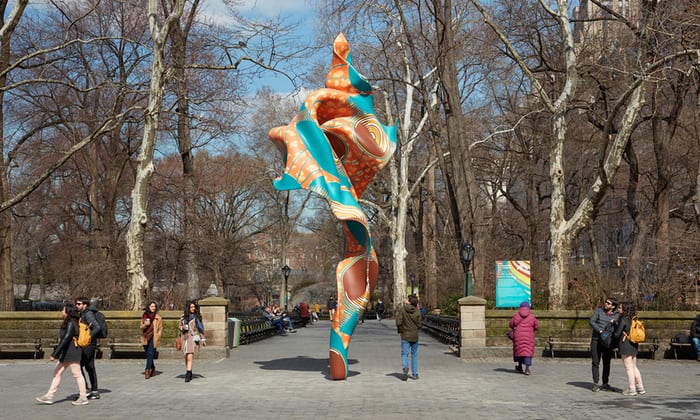Three blocks from Trump Tower, Yinka Shonibare’s new sculpture Wind Sculpture (SG) I was installed last week at the entrance to Central Park near 59th Street and Fifth Avenue. Dynamic folds emulate the sail of a ship, puffed by fanciful wind gusts and the intricate, hand-painted patterning in turquoise, red, and orange recalls Dutch wax batik fabrics—a familiar reference for Shonibare. These designs allow the Nigerian-British artist to unpack cultural identity in a globalized world. Presented by the Public Art Fund, Shonibare’s sculpture transcends staid public monuments and commemorative works of the past with a vivid alternative.
Inside the park—and elsewhere—the dialogue surrounding public commemorative works continues. The condemnation of Confederate monuments and the momentum of the #MeToo movement have converged as our nation’s monuments continue to be evaluated. All of the twenty-two historical figures in Central Park are male, and while fictional women like Alice in Wonderland and Mother Goose have statues, the first female statues honoring historical women are slated for completion in 2020. A site was dedicated to the future location of a memorial for Elizabeth Cady Stanton and Susan B. Anthony last year.
This Week in Women’s History Month
- The second edition of the public art exhibition Word on the Street debuts this month, featuring political works by Tania Bruguera and Laurie Anderson, as well as the writer A.M. Homes and the poet Naomi Shihab Nye. The all-female cast will bring protest art to the nexus of tourism and advertising in Midtown Manhattan: Times Square. Organized by the public art organization Times Square Arts, Word on the Street continues through August.
- A 43-foot tall neon uterus is now on view over Sunset Boulevard in Los Angeles. In place of the ovaries, two white fiberglass boxing gloves flank the glowing uterus. Champ is the first public installation by the British artist, Zoe Buckman, and the work will be installed for one year.
- During the museum’s “pay as you wish” hours, Maurizio Cattelan’s 18-karat toilet at the Guggenheim Museum was yarn-bombed by an anonymous artist last week. The golden threads used pay homage to the installation, entitled America (2016), and added a feminist twist.
- This Sunday, a workshop with artist Aliza Shvarts at the Ely Center of Contemporary Art in New Haven questions public exposure and shame in the digital landscape. A yearlong performance by Shvarts involving self-induced miscarriages gained national attention in 2008 while she was a senior at Yale University. Workshop participants are invited to consider and construct new parameters for the visibility for women.
- In a new Art21 video, artist Abigail DeVille talks about how the atrocities of history are the first to be forgotten or misremembered. Inspired by the Great Migration, DeVille’s The New Migration involves a public procession of musicians, dancers, and marching bands, dressed in the artist’s wearable sculptures which signify the “weight of history.”
Looking Back
In a video last year for the Art21 New York Close Up digital series, Meriem Bennani discusses how she used humor to bring the private lives of Muslim women to a public setting. Bennani’s Holiday Hijab series was displayed on the “Oculus” screen outside the Barclays Center as part of Public Art Fund’s Commerical Break series.




